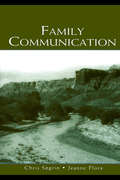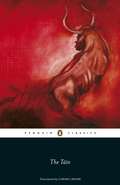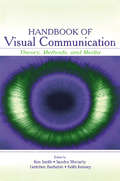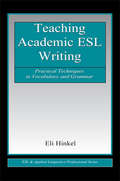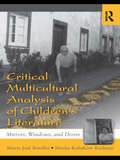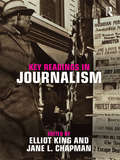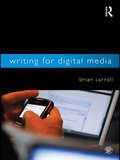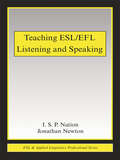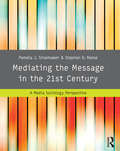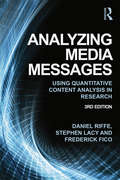- Table View
- List View
Family Communication: Chris Segrin (Lea’s Communication Series)
by Chris Segrin Jeanne FloraThis advanced text carefully examines state-of-the-art research and theories of family communication and family relationships. In addition to presenting cutting-edge research, authors Chris Segrin and Jeanne Flora focus on classic theories and research findings that have influenced and revolutionized the way scholars conceptualize family interaction. Showing that answers to many questions about family communication can be found in current scientific research, the book introduces readers to fundamental issues in the study of family communication; explores what is known about communication in different types of families and family relationships; and examines problematic issues in family communication. Family Communication offers a thorough and up-to-date presentation of scientific research in family communication for students and teachers of family communication, as well as professionals who work with families. Undergraduate readers will find the text to be accessible, engaging andeasy to understand while graduate students and professionals will utilize the work as a comprehensive reference to classic and contemporary research on family communication and relationships.
The Tain
by Ciaran CarsonThe Tain Bo Cualinge, centrepiece of the eighth-century Ulster cycle of heroic tales, is Ireland's great epic. It tells the story of a great cattle-raid, the invasion of Ulster by the armies of Medb and Ailill, Queen and King of Connacht, and their allies, seeking to carry off the great Brown Bull of Cualige. The hero of the tale is Cuchulainn, the Hound of Ulster, who resists the invaders single-handed while Ulster's warriors lie sick.
Family Communication (Lea’s Communication Series)
by Chris Segrin Jeanne FloraThis advanced text carefully examines state-of-the-art research and theories of family communication and family relationships. In addition to presenting cutting-edge research, authors Chris Segrin and Jeanne Flora focus on classic theories and research findings that have influenced and revolutionized the way scholars conceptualize family interaction. Showing that answers to many questions about family communication can be found in current scientific research, the book introduces readers to fundamental issues in the study of family communication; explores what is known about communication in different types of families and family relationships; and examines problematic issues in family communication. Family Communication offers a thorough and up-to-date presentation of scientific research in family communication for students and teachers of family communication, as well as professionals who work with families. Undergraduate readers will find the text to be accessible, engaging andeasy to understand while graduate students and professionals will utilize the work as a comprehensive reference to classic and contemporary research on family communication and relationships.
Language Exploration and Awareness: A Resource Book for Teachers
by Larry Andrews"Language Exploration and Awareness: A Resource Book for Teachers, Third Edition" shows English teachers how they can expand their curriculum beyond the traditional emphases on grammar and syntax, to help their students learn about many aspects of the English language, including general semantics, regional and social dialects, syntax, spelling, history of the English language, social language conventions, lexicography, and word origins. Clear, practical, and reader-friendly, the text reviews basic aspects of English language study in classrooms, then illustrates how teachers can create student-centered, inquiry-oriented activities for the learners in their classrooms. Written from a sociocultural perspective, this text stresses the uses of authentic language as it is used by real people for real purposes in diverse social contexts. Changes in the Third Edition are: all chapters have been thoroughly updated to address new developments in the world and in the field of English and language arts education; the chapters in Section II include new Student Explorations - activities designed by pre- and in-service teachers that readers can use with students in their classrooms; and new in this edition are references throughout several chapters to Web sites that instructors and students will find useful. This text is intended as text for undergraduate and master's level English language arts courses on the pedagogies of language teaching, and as an introduction to language or introduction to linguistics courses - particularly those emphasizing language study from a sociocultural perspective; and for courses preparing teachers of English as a new language. The text is also intended as a resource for current classroom teachers.
Language Exploration and Awareness: A Resource Book for Teachers
by Larry Andrews"Language Exploration and Awareness: A Resource Book for Teachers, Third Edition" shows English teachers how they can expand their curriculum beyond the traditional emphases on grammar and syntax, to help their students learn about many aspects of the English language, including general semantics, regional and social dialects, syntax, spelling, history of the English language, social language conventions, lexicography, and word origins. Clear, practical, and reader-friendly, the text reviews basic aspects of English language study in classrooms, then illustrates how teachers can create student-centered, inquiry-oriented activities for the learners in their classrooms. Written from a sociocultural perspective, this text stresses the uses of authentic language as it is used by real people for real purposes in diverse social contexts. Changes in the Third Edition are: all chapters have been thoroughly updated to address new developments in the world and in the field of English and language arts education; the chapters in Section II include new Student Explorations - activities designed by pre- and in-service teachers that readers can use with students in their classrooms; and new in this edition are references throughout several chapters to Web sites that instructors and students will find useful. This text is intended as text for undergraduate and master's level English language arts courses on the pedagogies of language teaching, and as an introduction to language or introduction to linguistics courses - particularly those emphasizing language study from a sociocultural perspective; and for courses preparing teachers of English as a new language. The text is also intended as a resource for current classroom teachers.
Handbook of Visual Communication: Theory, Methods, and Media (Lea’s Communication Series)
by Kenneth L. Smith Sandra Moriarty Keith Kenney Gretchen BarbatsisThis Handbook of Visual Communication explores the key theoretical areas in visual communication, and presents the research methods utilized in exploring how people see and how visual communication occurs. With chapters contributed by many of the best-known and respected scholars in visual communication, this volume brings together significant and influential work in the visual communication discipline.The theory chapters included here define the twelve major theories in visual communication scholarship: aesthetics, perception, representation, visual rhetoric, cognition, semiotics, reception theory, narrative, media aesthetics, ethics, visual literacy, and cultural studies. Each of these theory chapters is followed by exemplar studies in the area, demonstrating the various methods used in visual communication research as well as the research approaches applicable for specific media types.The Handbook serves as an invaluable reference for visual communication theory as well as a useful resource book of research methods in the discipline. It defines the current state of theory and research in visual communication, and serves as a foundation for future scholarship and study. As such, it is required reading for scholars, researchers, and advanced students in visual communication, and it will be influential in other disciplines in which the visual component is key, including advertising, persuasion, and media studies. The volume will also be useful to practitioners seeking to understand the visual aspects of their media and the visual processes used by their audiences.
Handbook of Visual Communication: Theory, Methods, and Media (Lea’s Communication Series)
by Kenneth L. Smith Sandra Moriarty Keith Kenney Gretchen BarbatsisThis Handbook of Visual Communication explores the key theoretical areas in visual communication, and presents the research methods utilized in exploring how people see and how visual communication occurs. With chapters contributed by many of the best-known and respected scholars in visual communication, this volume brings together significant and influential work in the visual communication discipline.The theory chapters included here define the twelve major theories in visual communication scholarship: aesthetics, perception, representation, visual rhetoric, cognition, semiotics, reception theory, narrative, media aesthetics, ethics, visual literacy, and cultural studies. Each of these theory chapters is followed by exemplar studies in the area, demonstrating the various methods used in visual communication research as well as the research approaches applicable for specific media types.The Handbook serves as an invaluable reference for visual communication theory as well as a useful resource book of research methods in the discipline. It defines the current state of theory and research in visual communication, and serves as a foundation for future scholarship and study. As such, it is required reading for scholars, researchers, and advanced students in visual communication, and it will be influential in other disciplines in which the visual component is key, including advertising, persuasion, and media studies. The volume will also be useful to practitioners seeking to understand the visual aspects of their media and the visual processes used by their audiences.
Teaching Academic ESL Writing: Practical Techniques in Vocabulary and Grammar (ESL & Applied Linguistics Professional Series)
by Eli HinkelTeaching Academic ESL Writing: Practical Techniques in Vocabulary and Grammar fills an important gap in teacher professional preparation by focusing on the grammatical and lexical features that are essential for all ESL writing teachers and student-writers to know. The fundamental assumption is that before students of English for academic purposes can begin to successfully produce academic writing, they must have the foundations of language in place--the language tools (grammar and vocabulary) they need to build a text. This text offers a compendium of techniques for teaching writing, grammar, and lexis to second-language learners that will help teachers effectively target specific problem areas of students' writing. Based on the findings of current research, including a large-scale study of close to 1,500 non-native speakers' essays, this book works with several sets of simple rules that collectively can make a noticeable and important difference in the quality of ESL students' writing. The teaching strategies and techniques are based on a highly practical principle for efficiently and successfully maximizing learners' language gains. Part I provides the background for the text and a sample of course curriculum guidelines to meet the learning needs of second-language teachers of writing and second-language writers. Parts II and III include the key elements of classroom teaching: what to teach and why, possible ways to teach the material in the classroom, common errors found in student prose and ways to teach students to avoid them, teaching activities and suggestions, and questions for discussion in a teacher-training course. Appendices to chapters provide supplementary word and phrase lists, collocations, sentence chunks, and diagrams that teachers can use as needed. The book is designed as a text for courses that prepare teachers to work with post-secondary EAP students and as a professional resource for teachers of students in EAP courses.
Teaching Academic ESL Writing: Practical Techniques in Vocabulary and Grammar (ESL & Applied Linguistics Professional Series)
by Eli HinkelTeaching Academic ESL Writing: Practical Techniques in Vocabulary and Grammar fills an important gap in teacher professional preparation by focusing on the grammatical and lexical features that are essential for all ESL writing teachers and student-writers to know. The fundamental assumption is that before students of English for academic purposes can begin to successfully produce academic writing, they must have the foundations of language in place--the language tools (grammar and vocabulary) they need to build a text. This text offers a compendium of techniques for teaching writing, grammar, and lexis to second-language learners that will help teachers effectively target specific problem areas of students' writing. Based on the findings of current research, including a large-scale study of close to 1,500 non-native speakers' essays, this book works with several sets of simple rules that collectively can make a noticeable and important difference in the quality of ESL students' writing. The teaching strategies and techniques are based on a highly practical principle for efficiently and successfully maximizing learners' language gains. Part I provides the background for the text and a sample of course curriculum guidelines to meet the learning needs of second-language teachers of writing and second-language writers. Parts II and III include the key elements of classroom teaching: what to teach and why, possible ways to teach the material in the classroom, common errors found in student prose and ways to teach students to avoid them, teaching activities and suggestions, and questions for discussion in a teacher-training course. Appendices to chapters provide supplementary word and phrase lists, collocations, sentence chunks, and diagrams that teachers can use as needed. The book is designed as a text for courses that prepare teachers to work with post-secondary EAP students and as a professional resource for teachers of students in EAP courses.
Critical Multicultural Analysis of Children's Literature: Mirrors, Windows, and Doors (Language, Culture, and Teaching)
by Maria José Botelho Masha Kabakow Rudman"Children’s literature is a contested terrain, as is multicultural education. Taken together, they pose a formidable challenge to both classroom teachers and academics…. Rather than deny the inherent conflicts and tensions in the field, in Critical Multicultural Analysis of Children’s Literature: Mirrors, Windows, and Doors, Maria José Botelho and Masha Kabakow Rudman confront, deconstruct, and reconstruct these terrains by proposing a reframing of the field…. Surely all of us – children, teachers, and academics – can benefit from this more expansive understanding of what it means to read books." Sonia Nieto, From the Foreword Critical multicultural analysis provides a philosophical shift for teaching literature, constructing curriculum, and taking up issues of diversity and social justice. It problematizes children’s literature, offers a way of reading power, explores the complex web of sociopolitical relations, and deconstructs taken-for-granted assumptions about language, meaning, reading, and literature: it is literary study as sociopolitical change. Bringing a critical lens to the study of multiculturalism in children’s literature, this book prepares teachers, teacher educators, and researchers of children’s literature to analyze the ideological dimensions of reading and studying literature. Each chapter includes recommendations for classroom application, classroom research, and further reading. Helpful end-of-book appendixes include a list of children’s book awards, lists of publishers, diagrams of the power continuum and the theoretical framework of critical multicultural analysis, and lists of selected children’s literature journals and online resources.
Critical Multicultural Analysis of Children's Literature: Mirrors, Windows, and Doors (Language, Culture, and Teaching)
by Maria José Botelho Masha Kabakow Rudman"Children’s literature is a contested terrain, as is multicultural education. Taken together, they pose a formidable challenge to both classroom teachers and academics…. Rather than deny the inherent conflicts and tensions in the field, in Critical Multicultural Analysis of Children’s Literature: Mirrors, Windows, and Doors, Maria José Botelho and Masha Kabakow Rudman confront, deconstruct, and reconstruct these terrains by proposing a reframing of the field…. Surely all of us – children, teachers, and academics – can benefit from this more expansive understanding of what it means to read books." Sonia Nieto, From the Foreword Critical multicultural analysis provides a philosophical shift for teaching literature, constructing curriculum, and taking up issues of diversity and social justice. It problematizes children’s literature, offers a way of reading power, explores the complex web of sociopolitical relations, and deconstructs taken-for-granted assumptions about language, meaning, reading, and literature: it is literary study as sociopolitical change. Bringing a critical lens to the study of multiculturalism in children’s literature, this book prepares teachers, teacher educators, and researchers of children’s literature to analyze the ideological dimensions of reading and studying literature. Each chapter includes recommendations for classroom application, classroom research, and further reading. Helpful end-of-book appendixes include a list of children’s book awards, lists of publishers, diagrams of the power continuum and the theoretical framework of critical multicultural analysis, and lists of selected children’s literature journals and online resources.
Exploring English Grammar: From formal to functional
by Caroline Coffin Jim Donohue Sarah NorthThis engaging textbook bridges the gap between traditional and functional grammar. Starting with a traditional approach, students will develop a firm grasp of traditional tools for analysis and learn how SFG (Systemic Functional Grammar) can be used to enrich the traditional formal approach. Using a problem-solving approach, readers explore how grammatical structures function in different contexts by using a wide variety of thought-provoking and motivating texts including advertisements, cartoons, phone calls and chatroom dialogue. Each chapter focuses on a real world issue or problem that can be investigated linguistically, such as "mis"-translation or problems arising from a communication disorder. By working on these problems, students will become equipped to understand and analyze formal and functional grammar in different genres and styles. With usable and accessible activities throughout, Exploring English Grammar is ideal for upper undergraduate and postgraduate students of English language and linguistics.
Exploring English Grammar: From formal to functional
by Caroline Coffin Jim Donohue Sarah NorthThis engaging textbook bridges the gap between traditional and functional grammar. Starting with a traditional approach, students will develop a firm grasp of traditional tools for analysis and learn how SFG (Systemic Functional Grammar) can be used to enrich the traditional formal approach. Using a problem-solving approach, readers explore how grammatical structures function in different contexts by using a wide variety of thought-provoking and motivating texts including advertisements, cartoons, phone calls and chatroom dialogue. Each chapter focuses on a real world issue or problem that can be investigated linguistically, such as "mis"-translation or problems arising from a communication disorder. By working on these problems, students will become equipped to understand and analyze formal and functional grammar in different genres and styles. With usable and accessible activities throughout, Exploring English Grammar is ideal for upper undergraduate and postgraduate students of English language and linguistics.
Key Readings in Journalism
by Elliot King Jane ChapmanKey Readings in Journalism brings together over thirty essential writings that every student of journalism should know. Designed as a primary text for undergraduate students, each reading was carefully chosen in response to extensive surveys from educators reflecting on the needs of today’s journalism classroom. Readings range from critical and historical studies of journalism, such as Walter Lippmann’s Public Opinion and Michael Schudson’s Discovering the News, to examples of classic reporting, such as Carl Bernstein and Bob Woodward’s All the President’s Men. They are supplemented by additional readings to broaden the volume’s scope in every dimension, including gender, race, and nationality. The volume is arranged thematically to enable students to think deeply and broadly about journalism—its development, its practice, its key individuals and institutions, its social impact, and its future—and section introductions and headnotes precede each reading to provide context and key points for discussion.
Key Readings in Journalism
by Elliot King Jane ChapmanKey Readings in Journalism brings together over thirty essential writings that every student of journalism should know. Designed as a primary text for undergraduate students, each reading was carefully chosen in response to extensive surveys from educators reflecting on the needs of today’s journalism classroom. Readings range from critical and historical studies of journalism, such as Walter Lippmann’s Public Opinion and Michael Schudson’s Discovering the News, to examples of classic reporting, such as Carl Bernstein and Bob Woodward’s All the President’s Men. They are supplemented by additional readings to broaden the volume’s scope in every dimension, including gender, race, and nationality. The volume is arranged thematically to enable students to think deeply and broadly about journalism—its development, its practice, its key individuals and institutions, its social impact, and its future—and section introductions and headnotes precede each reading to provide context and key points for discussion.
Writing for Digital Media
by Brian CarrollWriting for Digital Media teaches students how to write effectively for online audiences—whether they are crafting a story for the website of a daily newspaper or a personal blog. The lessons and exercises in each chapter help students build a solid understanding of the ways that the Internet has introduced new opportunities for dynamic storytelling as digital media have blurred roles of media producer, consumer, publisher and reader. Using the tools and strategies discussed in this book, students are able to use their insights into new media audiences to produce better content for digital formats and environments. Fundamentally, this book is about good writing—clear, precise, accurate, filled with energy and voice, and aimed directly at an audience. Writing for Digital Media also addresses all of the graphical, multimedia, hypertextual and interactive elements that come into play when writing for digital platforms. Learning how to achieve balance and a careful, deliberate blend of these elements is the other primary goal of this text. Writing for Digital Media teaches students not only how to create content as writers, but also how to think critically as a site manager or content developer might about issues such as graphic design, site architecture, and editorial consistency. By teaching these new skill sets alongside writing fundamentals, this book transforms students from writers who are simply able to post their stories online into engaging multimedia, digital storytellers. For additional resources and exercises, visit the Companion Website for Writing for Digital Media at: www.routledge.com/textbooks/9780415992015.
Teaching ESL/EFL Listening and Speaking (ESL & Applied Linguistics Professional Series)
by I.S.P. Nation Jonathan NewtonUsing a framework based on principles of teaching and learning, this guide for teachers and teacher trainees provides a wealth of suggestions for helping learners at all levels of proficiency develop their listening and speaking skills and fluency. By following these suggestions, which are organized around four strands – meaning-focused input, meaning-focused output, language-focused learning, and fluency development – teachers will be able to design and present a balanced program for their students. Teaching ESL/EFL Listening and Speaking, and its companion text, Teaching ESL/EFL Reading and Writing, are similar in format and the kinds of topics covered, but do not need to be used together. Drawing on research and theory in applied linguistics, their focus is strongly hands-on, featuring easily applied principles, a large number of useful teaching techniques, and guidelines for testing and monitoring. All Certificate, Diploma, Masters and Doctoral courses for teachers of English as a second or foreign language include a teaching methods component. The texts are designed for and have been field tested in such programs.
Teaching ESL/EFL Listening and Speaking (ESL & Applied Linguistics Professional Series)
by I.S.P. Nation Jonathan NewtonUsing a framework based on principles of teaching and learning, this guide for teachers and teacher trainees provides a wealth of suggestions for helping learners at all levels of proficiency develop their listening and speaking skills and fluency. By following these suggestions, which are organized around four strands – meaning-focused input, meaning-focused output, language-focused learning, and fluency development – teachers will be able to design and present a balanced program for their students. Teaching ESL/EFL Listening and Speaking, and its companion text, Teaching ESL/EFL Reading and Writing, are similar in format and the kinds of topics covered, but do not need to be used together. Drawing on research and theory in applied linguistics, their focus is strongly hands-on, featuring easily applied principles, a large number of useful teaching techniques, and guidelines for testing and monitoring. All Certificate, Diploma, Masters and Doctoral courses for teachers of English as a second or foreign language include a teaching methods component. The texts are designed for and have been field tested in such programs.
Mediating the Message in the 21st Century: A Media Sociology Perspective
by Pamela J. Shoemaker Stephen D. ReeseHailed as one of the "most significant books of the twentieth century" by Journalism and Mass Communication Quarterly, Mediating the Message has long been an essential text for media effects scholars and students of media sociology. This new edition of the classic media sociology textbook now offers students a comprehensive, theoretical approach to media content in the twenty-first century, with an added focus on entertainment media and the Internet.
Mediating the Message in the 21st Century: A Media Sociology Perspective
by Pamela J. Shoemaker Stephen D. ReeseHailed as one of the "most significant books of the twentieth century" by Journalism and Mass Communication Quarterly, Mediating the Message has long been an essential text for media effects scholars and students of media sociology. This new edition of the classic media sociology textbook now offers students a comprehensive, theoretical approach to media content in the twenty-first century, with an added focus on entertainment media and the Internet.
Analyzing Media Messages: Using Quantitative Content Analysis in Research
by Daniel Riff Stephen Lacy Frederick FicoAnalyzing Media Messages is a primer for learning the technique of systematic, quantitative analysis of communication content. Rich with examples of recent and classic applications, it provides solutions to problems encountered in conducting content analysis, and it is written so that students can readily understand and apply the techniques. This thoroughly revised third edition includes current and engaging examples for today's students, in addition to a number of historically important cases. It emphasizes communication of visual imagery and studies of advertising content. Resources on the book’s companion website provide additional materials for students and instructors, including existing protocols, web links, and a bibliography of content analysis methods articles. This volume is intended for use as a primary text for content analysis coursework, or as a supplemental text in research methods courses. It is also an indispensable reference for researchers in mass media fields, political science, and other social and behavioral sciences.
Analyzing Media Messages: Using Quantitative Content Analysis in Research (LEA Communication Series)
by Daniel Riff Stephen Lacy Frederick FicoAnalyzing Media Messages is a primer for learning the technique of systematic, quantitative analysis of communication content. Rich with examples of recent and classic applications, it provides solutions to problems encountered in conducting content analysis, and it is written so that students can readily understand and apply the techniques. This thoroughly revised third edition includes current and engaging examples for today's students, in addition to a number of historically important cases. It emphasizes communication of visual imagery and studies of advertising content. Resources on the book’s companion website provide additional materials for students and instructors, including existing protocols, web links, and a bibliography of content analysis methods articles. This volume is intended for use as a primary text for content analysis coursework, or as a supplemental text in research methods courses. It is also an indispensable reference for researchers in mass media fields, political science, and other social and behavioral sciences.
The Functional Analysis of English
by Thomas Bloor Meriel BloorThe Functional Analysis of English is an introduction to the analysis and description of English, based on the principles of systemic functional linguistics. It sets out the tools and analytic techniques of Hallidayan grammar with clear explanations of terminology and illustrates these with examples from a variety of texts, including science, travel, history and literary sources. This revised third edition incorporates references to recent research, better explanations of complex problems, and additional exercises. Key features: an updated overview of applications to real world issues revised sections on the current historical position of systemic functional grammar simple introductions to agnation, grammatical metaphor, and information structure chapter summaries, suggestions for further reading, exercises with answers and a glossary of terms a companion website with additional activities, exercises and supplementary readings for students and instructors This third edition is an indispensable introduction to systemic functional linguistics, which can be used independently or in preparation for M.A.K. Halliday and C.M.I.M. Matthiessen’s Introduction to Functional Grammar. The book is an ideal text for students of linguistics, applied linguistics and grammar- those new to the field, or who have a background in traditional grammar, as well as teachers of English language.
Introducing Functional Grammar
by Geoff ThompsonIntroducing Functional Grammar, third edition, provides a user-friendly overview of the theoretical and practical aspects of the systemic functional grammar (SFG) model. No prior knowledge of formal linguistics is required as the book provides: An opening chapter on the purpose of linguistic analysis, which outlines the differences between the two major approaches to grammar - functional and formal. An overview of the SFG model - what it is and how it works. Advice and practice on identifying elements of language structure such as clauses and clause constituents. Numerous examples of text analysis using the categories introduced, and discussion about what the analysis shows. Exercises to test comprehension, along with answers for guidance. The third edition is updated throughout, and is based closely on the fourth edition of Halliday and Matthiessen's Introduction to Functional Grammar. A glossary of terms, more exercises and an additional chapter are available on the product page at: https://www.routledge.com/9781444152678. Introducing Functional Grammar remains the essential entry guide to Hallidayan functional grammar, for undergraduate and postgraduate students of language and linguistics.
Introducing Functional Grammar: Introducing Functional Grammar
by Geoff ThompsonIntroducing Functional Grammar, third edition, provides a user-friendly overview of the theoretical and practical aspects of the systemic functional grammar (SFG) model. No prior knowledge of formal linguistics is required as the book provides: An opening chapter on the purpose of linguistic analysis, which outlines the differences between the two major approaches to grammar - functional and formal. An overview of the SFG model - what it is and how it works. Advice and practice on identifying elements of language structure such as clauses and clause constituents. Numerous examples of text analysis using the categories introduced, and discussion about what the analysis shows. Exercises to test comprehension, along with answers for guidance. The third edition is updated throughout, and is based closely on the fourth edition of Halliday and Matthiessen's Introduction to Functional Grammar. A glossary of terms, more exercises and an additional chapter are available on the product page at: https://www.routledge.com/9781444152678. Introducing Functional Grammar remains the essential entry guide to Hallidayan functional grammar, for undergraduate and postgraduate students of language and linguistics.
